LP79
| General Landscape Description: Bottom of a gilgai within an irrigated pasture of a plain. Original vegetation included Black Box (Eucalyptus largiflorens) and Lignum Bush (Muehlenbeckia cunninghamii). | |
| Mapped Soil Type: Tragowel Clay. |
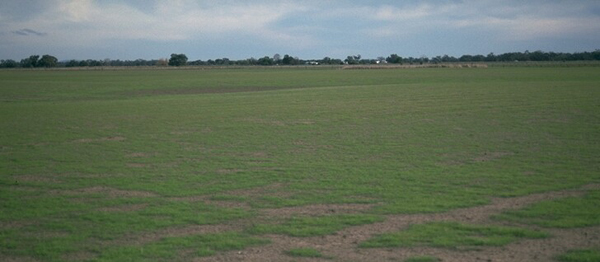 LP79 Landscape |
Soil Profile Morphology
Surface Soil
| A1 | 0-20 cm | Dark greyish brown (10YR4/2) with rusty root channel mottling; medium heavy clay; crusting surface condition; moderate coarse blocky structure (rough faced peds); firm consistence moist; pH 7.1; abrupt and smooth change to: | 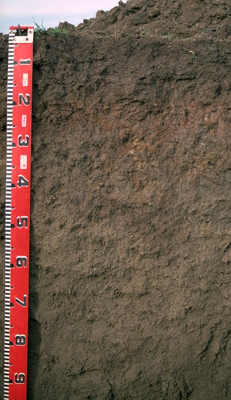 Lp79 Profile |
| Subsoil | |||
| B21 | 20-40 cm | Greyish brown (10YR5/2) with rusty root channel mottling as well as pockets of grey (10YR5/1) without mottling; medium clay; weak coarse blocky structure with compaction fractures; firm consistence moist; contains very few (<2%) magnesium flecks; pH 6.8; clear and wavy change to: | |
| B22 | 40-100 cm | Greysih brown (2.5Y5/2); medium clay; moderate fine polyhedral structure with minor slickensides; weak consistence moist; contains patches where there are a few (2-5%) carbonate and silica nodules (2-6 mm in size), some silica is magnesium coated; pH 7.9: | |
| B23 | 100+ cm | Greyish brown (2.5Y5/2); medium clay; salt was observed leaching out of the soil; pH 8.2. | |
Key Profile Features
- Accumulation of carbonate and silica nodules throughout the subsoil.
- Vertic properties (ie. significant shrink-swell characteristics).
Key Profile Characteristics
pH | Salinity Rating | |||
Surface (A1 horizon) | slightly alkaline | medium | sodic | none |
Subsoil (B21 horizon) | slightly acid | extreme | sodic | none |
Deeper subsoil (at 1 m) | moderately alkaline | extreme | strongly sodic | none |
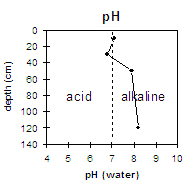 | 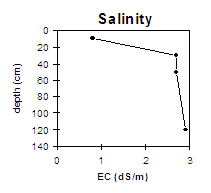 | 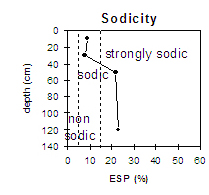 |
The surface is slightly alkaline. The upper subsoil is slightly acid becoming moderately alkaline with depth. | The salinity rating is moderate becoming extremely high at 20 cm. | The surface soil is sodic. The subsoil becomes strongly sodic at 40 cm. |
- Management Considerations:
- A very positive feature of this profile is that it has a high to very high inherent fertility in the surface and a high inherent fertility in the subsoil. This is very beneficial to plant growth.
- The surface soil has a crusting surface condition. The levels of organic carbon measured at the pit site (which may or may not be representative of the whole paddock) is low. Organic matter levels will build up under pasture but will decline if cropping takes place. Practices such as residue retention, minimum tillage and including pasture rotations could be utilised if cropping takes place, in order to build up organic matter and increase soil aggregation thus reducing crusting.
- The surface soil is sodic and disperses significantly after remoulding. This indicates that tillage or overstocking of the soil whilst in a moist to wet condition may result in structural degradation (e.g. surface sealing, increased cloddiness) occurring. Raindrop action on bare soil may have a similar effect, so it is important to maintain surface cover. Gypsum application may assist in improving surface soil structural condition on such soils.
- The surface is moderately saline and is likely to restrict the growth of salt sensitive plant species (e.g. faba beans, linseed, chickpeas and lupins).
- The surface has a very high clay content and thus water will not move through the soil very quickly. Interestingly, we observed rusty root channel mottling, a sure sign of water logging within old root channels.
- The subsoil is extremely saline at 20 cm and will restrict the growth of salt sensitive plant species (e.g. faba beans, linseed, chickpeas and lupins). We observed salt leaching out of the profile at about one metre.
- The coarsely structured subsoil is sodic becoming strongly sodic at 40 cm. There is no dispersion present and could be due to the extremely high salt, calcium and magnesium levels counteracting the effect of the sodicity. As a result, the sodicity is not likely to restrict root and water movement as significantly as would occur if the soil was not saline. Nevertheless, subsoil permeability will be low due to the low porosity of the clayey horizons.
- The subsoil displays vertic properties (ie. slickensides and compaction fractures) which indicates that significant shrinking and swelling occurs with wetting and drying cycles. This may disturb the roots of some plant species. The shrinking and swelling also has engineering implications (eg. disturbance to building foundations and fence lines).
- The high sodium and magnesium levels may have a toxic effect on some deep rooted plants.
Whole Profile
Surface (A) Horizon
Subsoil (B) Horizons
Profile described by Mark Imhof, Sonia Thompson and Paul Rampant, May 1995.


